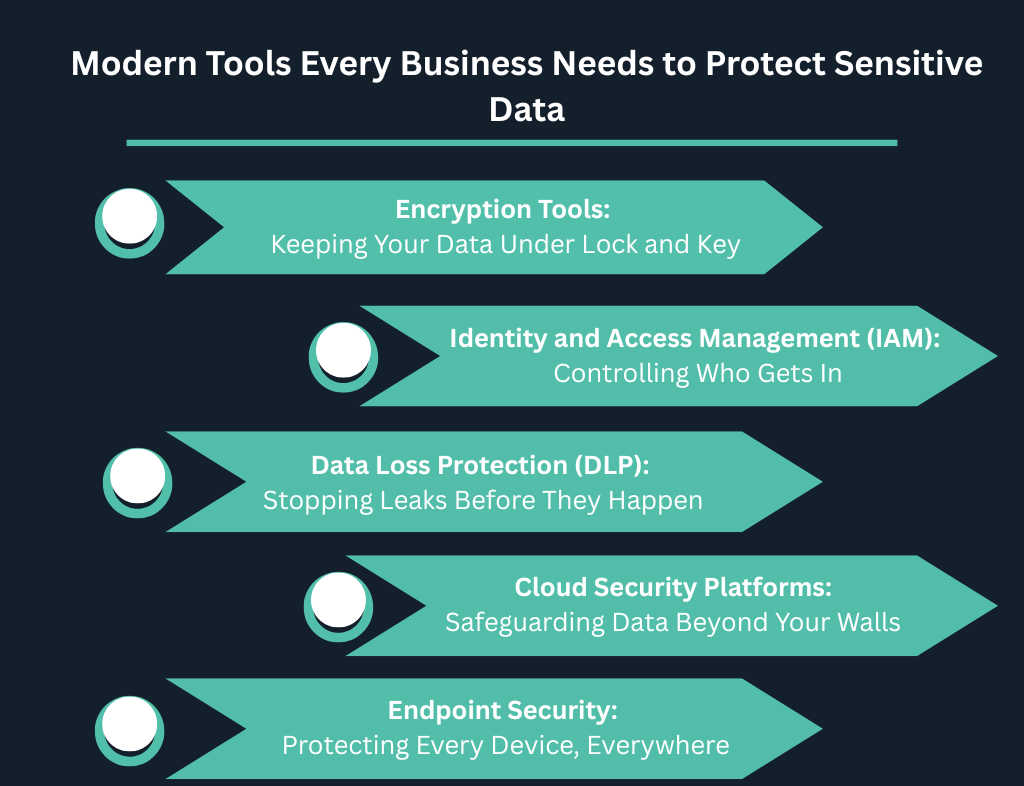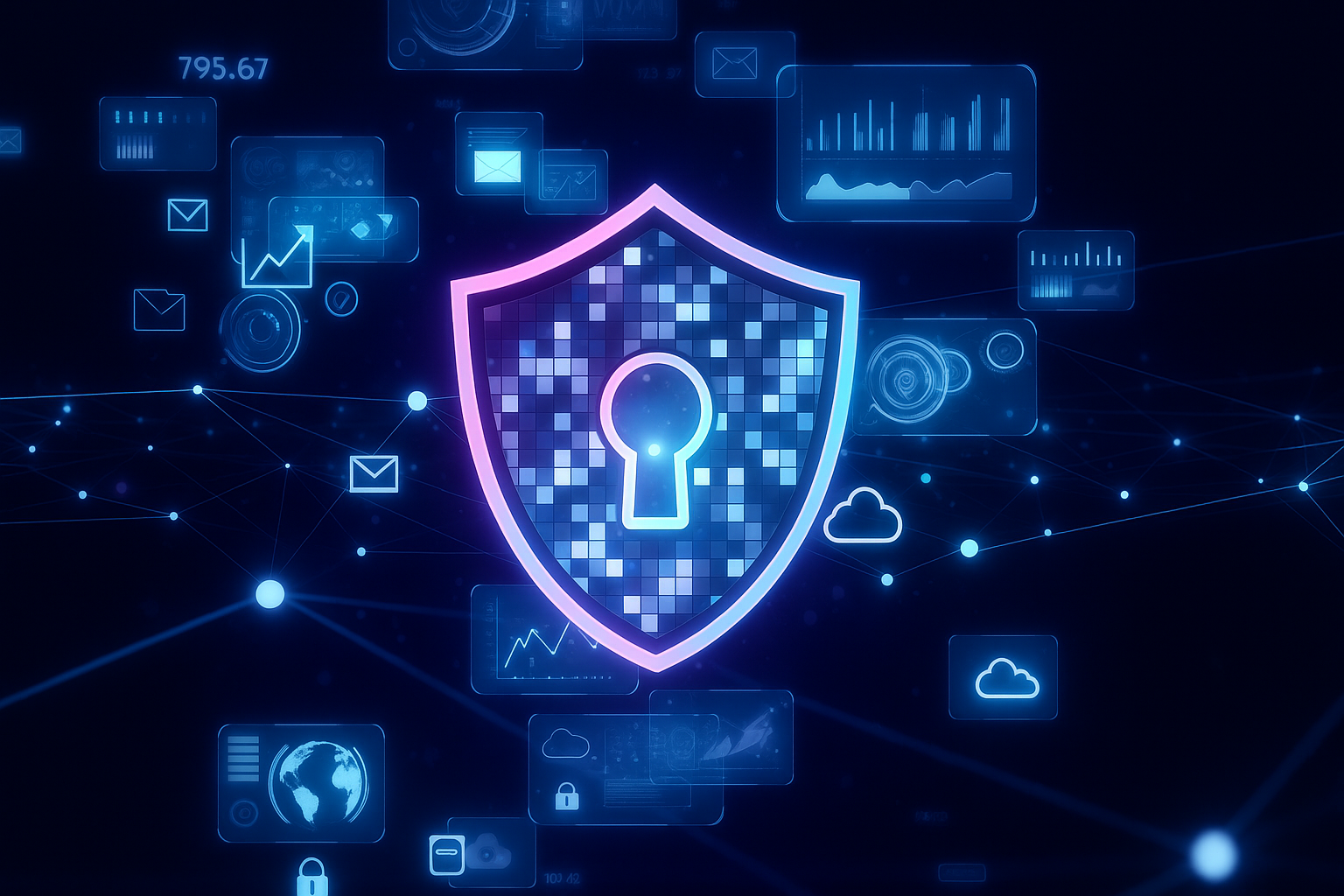In today’s digital world, data is the lifeblood of every business. From customer details and financial reports to marketing analytics and product designs, everything runs on data. But as technology advances, cybercriminals are getting smarter too. Just one weak spot can expose sensitive information, damage your reputation, and cost your business thousands ,sometimes even millions, to recover.
Protecting business data is no longer a choice; it’s a necessity. The good news is that modern cybersecurity tools make it easier than ever to safeguard information, detect threats early, and keep operations running smoothly.
You can read also: Modern Tools Every Business Needs to Protect Sensitive Data
Here are five essential tools every business needs to protect sensitive data, plus simple strategies to strengthen your overall cybersecurity approach.

Encryption Tools
Encryption is like placing your data inside a digital vault. It converts readable information into coded text that can only be accessed with a decryption key. Even if hackers intercept your files, they can’t understand the data without that key.
Popular tools such as BitLocker, VeraCrypt, and AxCrypt make it simple to encrypt everything ,from single files to entire drives. Leading cloud services like Google Workspace, Microsoft 365, and AWS also offer built-in encryption for data both in transit when being transferred and at rest when stored.
End-to-end encryption (E2EE) has become the gold standard for secure communication, ensuring that only the sender and recipient can view the message not even the service provider.
Encryption isn’t just smart it’s also required in many industries to meet compliance regulations like GDPR, HIPAA, and CCPA.
Identity and Access Management (IAM)
With remote and hybrid work now the norm, managing who can access what has become a serious security challenge. Identity and Access Management (IAM) tools help ensure that only authorized users can access your systems, applications, and data.
These tools combine Single Sign-On (SSO), Multi-Factor Authentication (MFA), and role-based access controls (RBAC) to create a layered defense system that balances convenience with strong protection.
Leading IAM platforms like Okta, Microsoft Entra ID (formerly Azure AD), and Ping Identity use adaptive authentication a feature that detects unusual behavior or login attempts in real time and blocks suspicious activity instantly.
Centralizing access through IAM not only reduces the risk of unauthorized entry but also streamlines employee logins, helping staff access what they need quickly and securely.
Data Loss Prevention (DLP)
Not all data leaks happen because of hackers. In many cases, human error is to blame like sending a file to the wrong email address or saving sensitive information on an unsecured drive.
Data Loss Prevention (DLP) tools help prevent those costly mistakes by monitoring how data moves within your organization and blocking risky activities before they happen.
Solutions such as Symantec DLP, McAfee Total Protection, and Digital Guardian can identify sensitive information and automatically restrict how it’s shared, copied, or transferred.
DLP systems can alert administrators when they detect a potential policy violation for example, if someone tries to email a confidential document outside the company.
Beyond preventing accidents, DLP helps businesses meet compliance standards and maintain customer trust.
Cloud Security Platforms
Cloud technology has transformed the way businesses store and share information. It offers flexibility, scalability, and accessibility but it also introduces new security risks.
Cloud security platforms help you monitor and protect your cloud environments from potential vulnerabilities, misconfigurations, and data breaches.
Top solutions like Palo Alto Prisma Cloud, Check Point CloudGuard, and Cisco Cloudlock give you complete visibility across your cloud assets. They continuously monitor for unusual behavior, enforce compliance policies, and detect risks using AI-powered analytics before they can escalate.
Whether you use public, private, or hybrid cloud systems, these tools ensure your business data stays secure, compliant, and well-protected from emerging threats.
Endpoint Security
Every connected device whether a laptop, smartphone, or tablet is a potential gateway for attackers. As remote work expands, endpoint security has become one of the most critical layers of defense.
Modern endpoint protection tools like CrowdStrike Falcon, Sophos Intercept X, and SentinelOne go far beyond traditional antivirus software. They use artificial intelligence and behavioral analytics to detect suspicious activities, quarantine threats, and prevent infections in real time.
If a device is compromised, these tools can isolate it from the rest of your network, stopping the threat from spreading. They also give IT teams full visibility and remote management capabilities so every device stays compliant and secure, no matter where employees are working.
How to fix it
Having advanced cybersecurity tools is crucial, but real protection goes beyond technology. Building a strong security culture within your organization is what keeps threats at bay long term. Here are a few smart, actionable steps to make your data protection even stronger:
- Conduct regular security assessments. Don’t wait for a breach to test your defenses. Perform risk audits and penetration tests to find and fix vulnerabilities early.
- Keep systems and software updated. Outdated software is a hacker’s favorite target. Enable automatic updates wherever possible.
- Train employees on cybersecurity best practices. Human error remains the top cause of breaches. Regularly train your staff to spot phishing emails, avoid unsafe downloads, and handle data responsibly.
- Adopt a Zero-Trust approach. Never assume anyone or anything is safe by default. Always verify before granting access.
- Use encrypted backups. Maintain secure backups both in the cloud and offline. In case of ransomware, you’ll have safe data copies to restore from.
- Establish clear data handling policies. Define how sensitive data should be stored, accessed, and shared, and make sure everyone follows those guidelines.
- Partner with cybersecurity professionals. If you don’t have an in-house team, consider a Managed Security Service Provider (MSSP) for 24/7 monitoring and quick threat response.
When you combine cutting-edge tools with smart, consistent habits, your business becomes resilient , ready to prevent, detect, and respond to cyber threats effectively.
Conclusion
Cybersecurity isn’t a one time project, it’s a continuous process. The right tools can block most threats, but true safety comes from awareness, discipline, and teamwork.
From encryption and IAM to cloud and endpoint security, every layer you add builds a stronger digital defense. And when your employees understand their role in keeping data safe, your organization becomes far more secure and trusted.
In a world where data drives every decision, protecting it isn’t just good practice,it’s the foundation for lasting growth, customer confidence, and long-term success
FAQs
Why is data protection so important for businesses?
Because a data breach doesn’t just lead to financial loss it erodes customer trust and brand reputation, which can take years to rebuild.
Are small businesses really at risk of cyberattacks?
Absolutely. Small and mid-sized businesses are often prime targets because hackers know their defenses are typically weaker.
How often should cybersecurity tools be updated or reviewed?
Review your security tools and policies at least twice a year, or whenever new technologies or employees are added to your systems.
What’s the difference between IAM and a regular login system?
IAM solutions go beyond passwords they provide centralized management, MFA, and user behavior analysis, making access both secure and seamless.
How do I choose the right cybersecurity tools for my company?
Start with a risk assessment. Identify your most sensitive data and select tools that match your company’s size, compliance needs, and budget.

